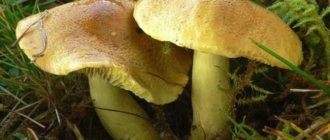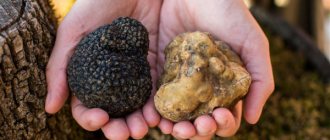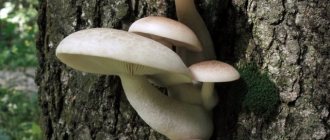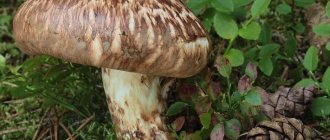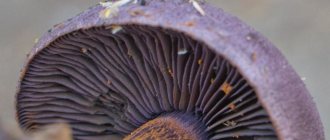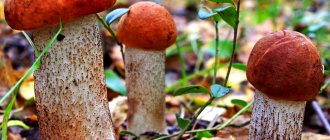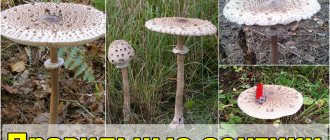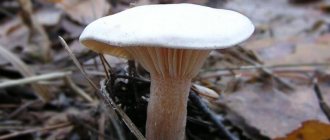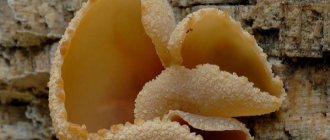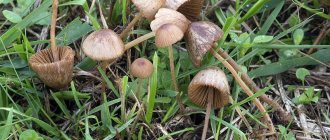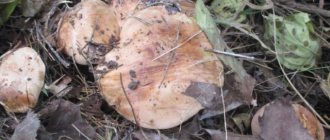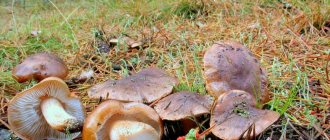There are more than 2 thousand varieties of rows in nature, although only a few dozen of them have been well studied. And even those varieties that are known to science cannot boast of excellent taste, most often falling into the conditionally edible group of categories III and IV.
That is why many experienced lovers of “quiet hunting” try to avoid these mushrooms, despite the fact that many of them have a rather impressive appearance and a dense, fleshy structure. But among all this abundance, a real pearl has been lost, which is worth its weight in gold on the Asian market, called a shod row.
What does a shod row look like (matsutake)
Shod row or tricholoma caligatum, has a wide cap, the diameter of which can reach 20 cm. The shade can vary from light brown to dark brown, or resin. Mature specimens have cracks located around the cap. This allows you to examine the soft body of the mushroom. There are many scales on the surface of the cap. The scales themselves are dark brown.
The thickness of the leg is on average 2.5-3 cm, and its length can reach 20-25 cm. At the base the leg is widest. It has a brown tint, a sharp downward slope, and is located near the ground. She also has a brown ring on her.
The lamellar body of the shod row is light in color; there is a small depression on the plates themselves. In young specimens, the lamellar body is hidden under a protective film, so it is not noticeable. As the mushroom grows, the film transforms into a ring at the bottom of the stem; its distinctive feature is the presence of a fringe.
In the row mushroom, the shod flesh on the stem has a white tint, the texture is elastic and dense. The spores are small in size and round in shape.
Species diversity
Among the varieties of the variety there are edible, conditionally edible and poisonous fruits.
Edible species
- Ryadovka zemstvenna (earthen): in youth it has a bell-shaped cap, in adults it is prostrate - up to 10 cm in diameter. The color of the cap is dark gray, the surface structure from a distance resembles a smoothed pile, the stem is white or light gray. On its surface, some representatives can see a “ring zone” - the remains of a private blanket. The pulp is whitish, dense with a pleasant floral aroma.
- The row is open-shaped, or tied: it has a ring on the stem that separates not just the stem into parts, but its color: above the ring (almost under the cap) the color is white, but under the ring it is reddish-brown, matching the cap.
Description of the species:
- The cap is up to 10 cm in diameter.
- The color of the cap is brown, sometimes there are remnants of a film cover on it. The edges are uneven.
- The pulp has a slight odor, fibrous, and bitter.
- The plates are frequent, white-cream.
- The row is gigantic: in representatives of this species the cap grows from 8 to 20 cm in diameter. It was also given the name gigantic row. The leg is up to 10 cm, the thickness is about 4 cm. The color of the cap is brown, the leg is white with brown spots. The pulp is dense, white. The species is classified as rare and is listed in the Red Book.
Irina Selyutina (Biologist):
The giant row is considered a mushroom with fairly good taste. In cooking, it is used both pickled and salted, but before cooking it must be boiled for 20 minutes to remove the bitterness. The pulp of the mushroom contains the antibiotic clitocin, which has the ability to destroy pathogenic bacteria, as well as cancer cells.
On the territory of Russia, giant row is found in some regions (Krasnoyarsk Territory, Kirov and Leningrad regions), where it forms mycorrhiza with coniferous trees. The species prefers pine forests, but it can also be found in the mixed forests of Crimea.
- The row is golden, or brown-yellow: it has yellow or yellow-brownish, so-called. hygrophanic caps. For your information. The hygrophanous nature of the caps is their ability to retain water. There is a small depression in the middle. The color is uniform, but there are rust spots. The pulp is dense with a characteristic anise smell and a bitter aftertaste. Most sources consider it poisonous, and a few - conditionally edible. But fruiting bodies are always processed by soaking and cooking.
- Ryadovka scaly, or brownish, or sweet or black-scaly: the color of the cap is reddish-brown or red-brown with scales. The leg is lighter, but with a uniform surface color. The shape of the leg is cylindrical, dense in young individuals, and with voids in adults. The scaly row has white-cream or brownish plates. The smell of the pulp is mealy. This species is classified as edible.
- The row is shod: a delicious look. Known under the names matsutake, pine mushroom, pine horns. Grows in the Far East, especially valued in Japan and China. In Russia they are found in the Urals, eastern Siberia, Amur and Khabarovsk regions. The search for fruiting bodies is made difficult by the foliage under which they hide. This mushroom has a cheesy, bitter taste and a pleasant anise smell. The peculiarity of the species is the leg planted deep into the soil. When harvesting the booted row, the fruiting bodies are dug out by hand to avoid damage. Description of the species:
- Hat: up to 20 cm in diameter. The color is white-brown, the edge is uneven. The cap is thick, elastic, and has scales in the light areas. Hymenophore lamellar.
- Leg: long, cylindrical. It tapers downward and is almost entirely in the soil. At the bottom there is a characteristic “stocking” with a “skirt”. It is white with brown streaks, and the “skirt” is also brown. Above the “skirt” the leg is white with small scales.
- Pulp: white with a pleasant fruity aroma.
Matsutake is a whimsical species. It requires special soil and temperature conditions. Does not grow in one place for more than 10 years. The fruiting period is September-early October.
- Ryadovka two-colored, or lilac-legged: an edible species of the genus. Resistant to low temperatures, therefore late. Fruiting bodies are collected until severe frosts. The hat is pillow-shaped and dense to the touch. The color is gray-violet or yellow-gray. The leg is long and cylindrical. The color of the leg is the same as that of the cap, but there are bright purple furrows or inclusions. The plates are frequent, white or grayish in color. The pulp is white with a pleasant fruity smell.
- Bearded row: the species has weak gastronomic characteristics. Belongs to the group of conditionally edible. The appearance is the same as that of the scaly row, but there is a fringe of fibers along the edge of the cap. Bearded row has a mild smell and taste.
- Brown row: similar to other species of the genus, which have a dark brown cap color. But in the brown row it tends more toward red-brown or yellow-brown. Along the outer concave edge of the cap you can see vertical dark brown stripes. With increased humidity, mucus forms on the surface of the leg. The pulp is dense, the smell is mealy, and the taste is bitter.
The row mushroom has many varieties
- Lepista weed, or dirty (Ryadovka weed, titmouse): the species belongs to the Ryadovka, but is not yet sufficiently studied. Her hat is dark gray in color, sometimes with a purple tint. The size can reach 8 cm in diameter. The pulp is not fleshy, but thin and fragile. Very often the hats fade. They are often confused with the species purple row, but there is no danger: both mushrooms are edible.
- Green row, or greenfinch, or lemon: the color of the fruiting body varies from greenish-yellow to light green. Sometimes there are bright yellow fruiting bodies. The color does not disappear during processing. In the center of the cap there is a dark gray spot covered with scales. Often cracks along the edge. The pulp is light lemon in color, darkens when scrapped, and has the smell of fresh flour. It grows only under coniferous trees.
- The row is naked, or purple: it is collected in the autumn. The appearance repels mushroom pickers, because in nature, in particular, brightly colored fruits are usually poisonous, both in plants and in mushrooms. But this species is conditionally edible. It differs from the lilac-legged row in the uniform color of the cap and purple legs. The pulp has a pleasant anise smell. This species is classified as a typical saprophyte.
Mushroom caps come in different colors:
- Violet;
- Blue;
- Lilac;
- Pink;
- Redhead;
- Orange.
They also distinguish the types of trees with which they create mycorrhizae. According to this criterion, the row mushroom enters into a symbiotic relationship and forms mycorrhiza with the following types of deciduous trees:
- Birch;
- Oak;
- Aspen;
- Alder.
However, row trees rarely form mycorrhiza with oak and prefer birch and conifers for these purposes. Delicious and juicy fruiting bodies grow under pine and aspen trees.
Inedible species
You need to be able to distinguish edible rows from inedible ones, because they cause intestinal disorders or poisoning.
- Row is fibrous: the fruiting bodies of the species are considered inedible due to their pungent taste. Outwardly, it looks like gray row, which has the taste and smell of flour.
- Tiger or leopard row: very dangerous for humans, because... can cause severe poisoning. The color of the cap is silver-blue with gray longitudinal scales. There is a convex tubercle in the middle. The plates are olive green. On the stem of mushrooms of the tiger row type, there is a characteristic powdery coating. The fruiting body deceives novice mushroom pickers with the pleasant smell of the pulp.
- Soap row: got its name because of the specific smell of the pulp, which is reminiscent of cheap soap. Mushrooms of this species have a hemispherical cap with a wavy edge. Along the outer circle its color is light gray, towards the center it darkens to the color of dark copper. The leg is gray, long. At the break the flesh turns red. When cooking, the unpleasant smell only intensifies.
- The row is pointed, or mouse-like, or stinging-sharp, or striped: it looks like the earthy-gray row. It contains in the pulp a certain amount of muscarine, which is classified as a strong poison. But the main differences between this dangerous species are:
- Umbrella shape of the cap and a pointed prominence in the middle.
- Bitter taste, mealy smell.
- The color of the cap is uneven, sometimes with white patches. In wet weather, mucous surface.
- Ryadovka spotted, or destroyed, or speckled: slightly poisonous species. Outwardly it looks like an edible one, but differs from the safe rows by small dark purple or gray spots on the cap closer to the edge. There is also mucus on the cap and the stalk is fibrous. It darkens when touched and when broken. If consumed, it may cause gastrointestinal upset.
- Stinking rower: cases of poisoning by this species are known in Russia, although the growing area is limited to the Amur region:
- The fruiting body of the species is completely white. The cap is spread out with a tubercle in the middle and uneven edges. A system of plates (hymenophores) fused with the cap.
- The poisonous pulp has the smell of illuminating gas or tar, which is why the species received its name. The dangerous toxin causes auditory and visual hallucinations.
- Sultry spruce row: extremely similar to edible greenfly. It has a dirty green-yellowish cap color. It is often confused with milk mushrooms, but they form mycorrhiza with deciduous trees, and sultry - only with representatives of coniferous species. Adults of this row have a funnel in the center of the cap.
Where does the shod row grow in Russia?
Ryadovka shod or matsutake grows in countries such as Japan, China, Korea, Sweden, and Russia. Found in areas where sandy soil covered with moss predominates. Most often - in pine forests and coniferous forests. Sometimes rowing is found in parks and gardens.
This mushroom is considered quite rare; in almost all regions of the country it is included in the regional red books. The row can be found on the Kola Peninsula of the Murmansk region. Shod row is sometimes found in the Leningrad region and grows in forests. The most optimal time for collection is considered to be autumn, mainly the month of October.
Some varieties are also found in other areas. The gray shoeed rower is found in the Moscow region in coniferous and mixed forests. It can be found from August until the first frost.
The shod row is most often found in the Urals. Mainly in the Irkutsk and Amur regions, as well as in the Khabarovsk Territory.
How to find a shod row
This type of mushroom is distinguished by the fact that it grows quite deep. In some cases, the row has to be dug up, since its leg is located far in the ground. It is quite difficult to detect it with the naked eye. The mushroom picker has to carefully peer into the ground, since more often the row is camouflaged under fallen leaves or under moss.
Mostly matsutake hides under white moss, but is sometimes found under coniferous trees or oaks. The mushroom is located at the very foot of the tree, and it grows only in oak trees that are at least 70 years old. The row grows around the tree trunk, forming a ring shape.
It is necessary to search in infertile soil. When the leaves fall, the soil becomes most fertile, and in such conditions the fungus stops reproducing. This explains that the row does not bear fruit in the same place for more than 8 years.
Matsutake grows only under certain climatic conditions. It can only be found in areas where the daytime temperature does not exceed 26°C, while at night the temperature does not drop below 15°C. It grows most readily during periods of heavy rainfall.
Important! When collecting rows, it is forbidden to break the mycelium; it must be cut with a knife, otherwise it will lead to the death of the whole family.
Additional information about mushroom picking in this video:
Is it possible to eat spotted rower?
Spotted row is considered an edible mushroom. In Asian countries, special attention is paid to the row, as it is considered a delicacy and is used to prepare many dishes.
Attention! Among the rows there are also poisonous specimens; their characteristic feature is a sharp unpleasant odor, which intensifies when broken.
In order not to cut off a poisonous mushroom, when collecting, you should take into account the characteristic features related to edible specimens:
- thick layer of pulp;
- small cracks on the edges;
- slightly convex hat;
- the leg has a cylindrical shape;
- there are records;
- the smell is weak.
Poisonous and edible mushrooms differ not only in smell, but also in appearance. Edible matsutake has a white flesh that is firm and not watery. The leg is long, dark brown. It is difficult to remove from the soil.
Similar species:
Poplar row at a young age is a little similar to crowded row in color and shape but, unlike it, it is much larger than it in size and has a slightly bitter taste due to the fact that it grows in such conditions that the cut mushroom is almost completely covered with sand or small debris. It is for this bitter taste that some open sources classify it as a conditionally edible mushroom.
Some inexperienced collectors may also confuse it with the poisonous tiger rower. But there are many things that distinguish them, but the main differences are that, firstly, the poplar row always grows in very large groups and near poplars; secondly, they are distinguished by coloring; in the brindle row it is more white-gray with a dark gray shading in the center of the cap.
Poplar row is a very productive and easily harvested mushroom, growing in whole ridges and having a fairly high nutritional value. Therefore, it is especially valued in the steppe regions of Russia, which are poor in other valuable mushrooms (for example, in the Saratov, Volgograd, Omsk regions and Altai Territory)
In terms of its taste and consumer qualities, poplar row belongs to the edible mushrooms of the fourth category and is completely suitable for consumption, but only after it has been soaked or boiled in order to eliminate the bitterness in it.
Taste qualities of mushroom
Ryadovka has a bright taste; its taste is slightly reminiscent of pear and pine needles. Their taste goes well with potatoes and fried onions. They are often added to various salads, combined with rice, bell pepper, mayonnaise, garlic and paprika. All possible methods are used for cooking; mushrooms can be pickled, salted, stewed, fried and boiled.
The taste is slightly bitter, the smell resembles the aroma of anise.
Cooking methods
Matsutake is an exotic mushroom and the recipes for its preparation are quite simple, since Asian cuisine is primarily based on the freshness of the product. This involves a minimal amount of additional ingredients and almost no heat treatment.
Shod row: where it grows, what it looks like and how it is useful
Here are four of the most basic recipes used in Asian countries.
- Matsutake with rice - boiled rice (washed three times) and lightly fried chicken breast are mixed with carrots, seaweed, 100 grams of canned city, a few tablespoons of soy sauce and peeled rows lightly scalded in water.
- Dobin Mushi – marinated chicken breast and pre-boiled king prawns are added to pots with chopped mushrooms. The mass is filled with thick shrimp broth and half a liter of cold sake. After an hour, seafood is added to the pots.
- Gohar Matsutake - fine Japanese rice is washed until translucent and boiled in seaweed broth. Separately cut into strips, Matsutake and 100g of tofu are stewed in soy sauce mixed with sake. The resulting ingredients are mixed and infused for an hour.
- Row with fish - cod fillet is processed in a steam pan with the addition of onion, chopped ginger, broccoli and green peas. Before finishing cooking, add matsutake to the pan, finally seasoning the dish with zucchini
Bon appetit!
False doubles
Poisonous counterparts of matsutake are quite rare. A poisonous mushroom is easy to distinguish from an edible one, as it has bright features. The poisonous gray row is distinguished by its appearance, since its flesh has a dull gray color, the texture is uneven and slimy. Its use causes severe gastrointestinal disturbances.
White poisonous row, despite its name, does not have a white tint. Its color is inconspicuous, gray-white. Juveniles have virtually no odor. However, when they break, a sharp and unpleasant odor appears. False specimens have a different color of hat, it resembles the color of a leopard and has a large number of spots.
Important! To identify the false mushroom, it is recommended to slightly break the flesh. Poisonous specimens have a pungent odor.
The type of inedible row is shown in the photo.
Useful properties and use in medicine
You may be interested in: How do edible talkers differ from false mushrooms? How many days after rain do mushrooms grow? Bitter mushroom: photo and detailed description
Few people know that some varieties of mushrooms have healing properties and are widely used in medicine. Matsutake is a clear example of this, and not only because of its high nutritional value and low calorie content, which allows it to be considered a dietary variety. Thus, regular consumption of this nutritious and very tasty product allows you to normalize blood pressure and blood glucose levels, significantly facilitating the general well-being of hypertensive and diabetic patients, even without medications.
The mushroom also has antiviral and antibacterial properties, preventing the development of tumor tumors. Another useful feature of the booted row is that its inclusion in the diet helps in the fight against age spots and age-related changes due to its rich composition, replete with vitamins, minerals, amino acids and antioxidants. Scientists have proven that the mushroom is able to cleanse the gastrointestinal tract and liver, remove toxins from the body, and also strengthen the immune system, containing in abundance the following beneficial substances:
Collection rules
It is recommended to collect rows of mushrooms in the autumn, and the largest number of mushrooms can be observed during the first cold weather. The exact collection period depends on the specific area: in some regions, matsutake can be found as early as August. But it is best to go to the forest in the first autumn months, when the leaves begin to fall.
When collecting matsutake, you should not pull out the mushroom; it is carefully cut off with a knife so as not to damage the entire mycelium. Rowing is sought in open areas, especially in areas where a large amount of moss grows. It is also found at the base of trees. A distinctive feature is that several mushrooms form a whole row.
Use
Matsutake mushrooms are subjected to heat treatment, they are also pickled and salted. Raw consumption is contraindicated. It is not recommended to eat old mushrooms, as they have the ability to accumulate anthropogenic pollution. If you eat too much and too often, gastrointestinal disturbances may occur.
These mushrooms are used not only in cooking, but also in cosmetology and medicine. Some antibiotics, drugs for diabetics, as well as medications for the treatment of cancer are produced on their basis. Matsutake is also used to treat skin diseases: used as lotions.
How to grow a booted row
Growing shod rows is a rather complex process. The algorithm is similar to growing champignons. The crop is planted in May; dry straw and horse manure or bird droppings can be used as soil. They can be grown in garden beds or at home. A prerequisite is compliance with the temperature regime - the air temperature should not fall below 15°C.
After planting, it is very important to create high humidity. You need to add soil, the average thickness of which is 5 cm. For successful cultivation there must be a sufficient level of light, as well as fresh air.
If you want to grow matsutake yourself, take into account all the requirements. Growing conditions must be suitable. It is best to use a summer cottage for these purposes, since at home these mushrooms do not have enough light and air, which leads to their death.
Preparing a bed for garlic
Experienced gardeners advise pre-growing green manure in the beds. These are plants that fertilize the fertile layer with the nutrition necessary for a particular crop. Garlic is often infested by helminths - nematodes. They settle in stems and destroy seedlings. After growing phacelia and white mustard in beds, nematodes do not attack garlic.
When is the best time to plant green manure? This is done when preparing the land for winter: after harvesting and digging. The plot is sown with green manure, and then it is plowed into the ground. Over the winter, the stems will rot and enrich the soil with nutrition.
